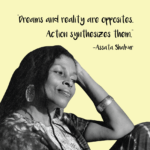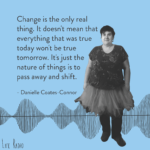Most of us will be known by future generations not for our individual reputation, but for who we were together. The sum of our actions now changes their fate.
Legacy, our mark on the planet, is defined in three ways: as wealth, transmission or membership. We can explore these variations to align our current actions with our desired generational legacy.
Legacy as Wealth
Perhaps the most commonly known definition of legacy is the wealth or money that passes to the next generation. Has your family been supported or suppressed by society in cultivating surplus resources? Maybe you’ve received an inheritance of money. Or maybe you have a goal to leave behind a legacy of money and resources for future generations in your lineage or in the society. Looking at our individual relationship to inherited material wealth, noticing the places where we experience ease or struggle, provides clues into what we can build across the society.
Today, everybody is not starting at the same place. For example, people with race privilege often show a blind spot when they say, “I’ve worked so hard for everything I have.” Maybe they did, alongside the truth that laws, tax systems, government subsidies, the ability to own land, and other structures have favored white people for generations. While hard work may be a pixel, we’re not understanding the full picture of the economy if we believe hard work and “boot straps” are the only factors to create a wealth legacy.
Legacy as Transmission
We can explore legacy as transmission. This is the wisdom, ritual, art, culture, artifacts and creativity that create the legacy we leave behind. Our ancestors left bread crumbs we encounter through how we’ve been influenced and the practices we choose to abandon or continue. Just as ceremonial rites of passage contain transmission, knowing exactly what herbs and spices season the family sauce is engaging our ancestor’s legacy, too.
It is important to acknowledge the loss of transmission that has occurred through colonization, repression, and forced assimilation. We must analyze how popular culture perpetuates stereotypes, advances stories selected by institutions with unjust policies, and amplifies works that have the greatest potential to earn funds. When asked how the masterpiece 1971 album What’s Going On was created, Marvin Gaye says it was channeled to him. Transmission is happening, and artifacts have the power to bring light the most potent possible interventions. Listening to that album today is an artifact of justice struggles fifty years ago, still very relevant today.
Beyond the intellectual, how can we feel and know our way to freedom? What we make now are the crumbs future generations will find.
Legacy as Membership
Legacy can also take the form of membership, or belonging. Networks, visible and invisible, are the way of nature and thus, society. Access to elite institutions have been passed down, causing knowledge, wealth, and opportunity to recirculate among the same communities. Turn towards that. What are the institutions that you’ve either had access to, or been blocked from as a result of legacy? And then imagine, how would you like it to be for future generations?
In this way, we can create new formations of belonging, membership. We can build the structures that help our families, neighborhoods, towns, cities, states, regions, and countries thrive. Notice what identities you belong to that hold you back from offering your complete self. Imagine a structure that should exist in society to help more people have a healthy and secure sense of belonging
Make it Beautiful
The objects, transmissions, and memberships we cultivate in our lifetime are the footprints we leave on the planet. We are building the world where future generations will live. They will know our mark as collective. May our legacy make their lives easier. May our individual life forces culminate to a larger, more gorgeous legacy.



